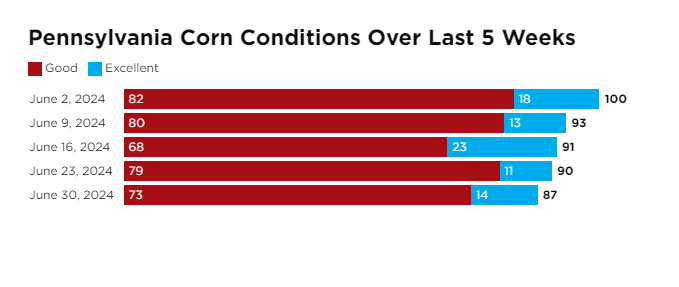Pennsylvania corn progress and condition
Ninety-seven percent of Pennsylvania’s corn had emerged as of June 30, according to USDA. That represented an increase of 3 percentage points for the week, the same percentage as that reported last year at this time, and up 2 percentage points compared to the five-year average.
There was no corn silking in Pennsylvania to report as of June 30. That was expected based on historical data: None of the state’s corn crop was silking last year at this time, and the five-year average is zero.
“For the week ending June 30, USDA rated 87% of Pennsylvania’s corn good to excellent. It’s the lowest percentage of good-to-excellent corn the state has seen since USDA began rating corn this season. The corn has held strong, with 100% good-to-excellent as of June 2, 93% as of June 9, 91% as of June 16, 90% as of June 23, and 87% as of June 30.”.

According to Monday’s report, Pennsylvania topped the top-producing states for good-to-excellent corn by 7 percentage points; Nebraska ranked second with 80% good-to-excellent corn. Moreover, Pennsylvania remained the only state that hasn’t had any corn rated very poor since USDA began rating corn this season.
Pennsylvania weather
According to USDA, the state had above average temperatures the week ending June 30. The departure from normal was 1.38°. As for precipitation during the same week, the departure from normal was 0.51 inches. However, for the last 4 weeks, the departure from normal was -1.11 inches.
According to the latest report from the U.S. Drought Monitor, slightly more than 58% of Pennsylvania was considered abnormally dry, while a little more than 9.8% of the state was in moderate drought as of July 2. It marks a huge move toward dry and drought conditions for the state. Only a week earlier, as of June 18, slightly less than 13% of the state was considered abnormally dry and none of the state was experiencing moderate drought conditions.
State climatologist comments on great conditions
Pennsylvania’s state climatologist, Kyle Imhoff, said he wasn’t surprised by the numbers from the USDA and explained why.
“Across the state, we generally have not had weather conditions that have been overly stressful to the crop through the late spring and early summer,” said Imhoff. “Soil moisture levels for much of this time were near to slightly above normal and temperatures were a few degrees above normal.”
When asked whether he did expect the state’s corn crop to stay that good in the coming weeks and overall this season, Imhoff provided the following input: “The largest impact that I could see on crop health would be in far southeastern Pennsylvania where drought conditions and drier soils have been worsening over the past few weeks.”.